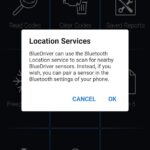Encountering a check engine light in your 2015 Honda Fit can be concerning, but understanding how to access and interpret the diagnostic codes can empower you to troubleshoot potential issues effectively. This guide will walk you through locating your 2015 Honda Fit OBD2 connector and using a simple method to retrieve error codes without needing a professional scan tool right away.
Understanding the OBD2 Connector on Your 2015 Honda Fit
OBD2, or On-Board Diagnostics II, is a standardized system in modern vehicles that provides access to vehicle health information. The OBD2 connector is a crucial interface that allows mechanics and car owners to retrieve diagnostic trouble codes (DTCs) when the check engine light illuminates. These codes pinpoint potential malfunctions within your vehicle’s systems.
Locating the OBD2 Connector in Your 2015 Honda Fit
For the 2015 Honda Fit, the OBD2 connector is typically located in an easily accessible spot under the dashboard on the driver’s side. You’ll usually find it near the steering column or within the vicinity of the pedals. It’s a 16-pin, trapezoid-shaped port, and you might need to crouch down and look under the dash to spot it.
Reading Error Codes Manually on Your 2015 Honda Fit
While professional OBD2 scanners offer the most user-friendly way to read codes, you can also retrieve basic error codes manually on your 2015 Honda Fit using a simple paper clip or jumper wire. This method utilizes the Malfunction Indicator Lamp (MIL), also known as the check engine light, to flash out the diagnostic codes.
Materials You’ll Need
- Paper clip or jumper wire
- Honda service manual or a reliable online list of Honda OBD2 codes
Step-by-Step Guide to Reading Codes
-
Turn off the ignition and remove the keys: Ensure your 2015 Honda Fit is completely turned off before starting this process.
-
Locate the OBD2 connector: Find the 16-pin OBD2 connector under the dashboard on the driver’s side of your Honda Fit.
-
Prepare your paper clip: Straighten out a paper clip or use a jumper wire to create a small U-shape.
-
Insert the paper clip into pins 4 and 9: Carefully insert the ends of the paper clip or jumper wire into pins 4 and 9 of the OBD2 connector. Pin 4 is typically the chassis ground, and pin 9 is the service check connector.
-
Turn the ignition to the “ON” position (II): Turn your key to the position right before starting the engine. This will power on the vehicle’s systems without starting the engine.
-
Observe the MIL flashes: Watch the check engine light (MIL) on your dashboard. It will begin to flash a series of long and short flashes.
-
Interpret the flashes: Count the number of long flashes and multiply by 10. Then, count the number of short flashes and add them to the previous result. This combination represents a Diagnostic Trouble Code (DTC). For example, 2 long flashes followed by 3 short flashes would indicate code 23.
-
Reference the DTC code: Once you have the DTC code, you’ll need to consult a Honda service manual or a reliable online Honda OBD2 code list to understand what the code signifies. Below is a common list of Honda CEL codes for reference:
Common Honda OBD2 Error Codes
- 1: O2A – Oxygen sensor #1
- 2: O2B – Oxygen sensor #2
- 3: MAP – Manifold Absolute Pressure sensor
- 4: CKP – Crank Position Sensor
- 5: MAP – Manifold Absolute Pressure sensor
- 6: ECT – Engine Coolant Temperature sensor
- 7: TPS – Throttle Position Sensor
- 8: TDC – Top Dead Center sensor
- 9: CYP – Cylinder sensor
- 10: IAT – Intake Air Temperature sensor
- 12: EGR – Exhaust Gas Recirculation lift valve
- 13: BARO – Atmospheric Pressure sensor
- 14: IAC (EACV) – Idle Air Control Valve
- 15: Ignition output signal
- 16: Fuel Injectors
- 17: VSS – Vehicle Speed Sensor
- 19: Automatic Transmission lockup control valve
- 20: Electrical Load Detector
- 21: VTEC Spool Solenoid Valve
- 22: VTEC Pressure Valve
- 23: Knock Sensor
- 30: Automatic Transmission A signal
- 31: Automatic Transmission B signal
- 36: Traction control (JDM ECUs)
- 41: Primary Oxygen Sensor Heater
- 43: Fuel Supply System
- 45: Fuel System Too Rich or Lean
- 48: LAF – Lean Air Fuel Sensor
- 54: CKF – Crank Fluctuation Sensor
- 58: TDC Sensor #2
- 61: Primary Oxygen Sensor
- 63: Secondary Oxygen Sensor Circuit
- 65: Secondary Oxygen Sensor Heater Wire (black wires)
- 67: Catalytic Converter Efficiency Below Threshold
- 71-74: Random Misfire Cylinder (1-4)
- 80: EGR Valve/Line
- 86: ECT Sensor – Cooling System
- 91: Fuel Tank Pressure Sensor
- 92: EVAP Solenoid/Valve/Vacuum Lines
Conclusion
Manually reading OBD2 codes on your 2015 Honda Fit using the paper clip method is a basic troubleshooting step. While it provides a starting point, it’s important to remember that this method is less comprehensive than using a dedicated OBD2 scanner. For in-depth diagnostics and clearing codes, a scan tool is recommended. If you are unsure about interpreting the codes or addressing the underlying issue, always consult a qualified mechanic for professional diagnosis and repair.
